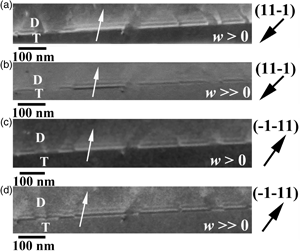Article contents
Analysis of Electron Channeling Contrast of Stacking Faults in fcc Materials
Published online by Cambridge University Press: 22 January 2021
Abstract

The characteristics of electron channeling contrast (ECC) of stacking faults in a [101] single-crystal 316L fcc (face-centered cubic) stainless steel have been evaluated. Channeling contrast was analyzed from a series of ECC images taken as a function of sample tilt at ~0.1° increments across the (111) Kikuchi band. The most relevant imaging parameters of the fault contrast, namely the number of fringes, fringe intensity, and fringe spacing, were analyzed under different channeling conditions. The present work shows that the channeling contrast of stacking faults exhibits strong dependence on the sign and magnitude of the deviation parameter, w (w = s ξg, where s is the excitation vector and ξg is the extinction distance). This effect has strong influence on channeling conditions for fault imaging and g.R analysis for determining the nature of a stacking fault. g.R analysis was evaluated by the method developed by Gevers et al. (1963) on g-reversion experiments of ECC images of a stacking fault configuration. The interplay between the stacking fault nature and ε-martensite is analyzed.
- Type
- Software and Instrumentation
- Information
- Copyright
- Copyright © The Author(s), 2021. Published by Cambridge University Press on behalf of the Microscopy Society of America
References
- 5
- Cited by





